Last Updated on March 22, 2024 by Packoi Team
Did you know that around 60% of all the plastic made worldwide is used for packaging food? To give you an idea, out of the 380 million metric tons of plastic produced in 2015, a whopping 228 million metric tons were solely used for packaging food.
Given the negative impact of non-biodegradable plastic packaging on the environment and human health, many people are actively working to reduce plastic production by encouraging the use of more sustainable food packaging options.
If you’re in the food industry and want to make an eco-friendly choice, here’s how to choose the right packaging for your food product. Let’s take a deeper look!
Why is Eco-Friendly Food Packaging Important?
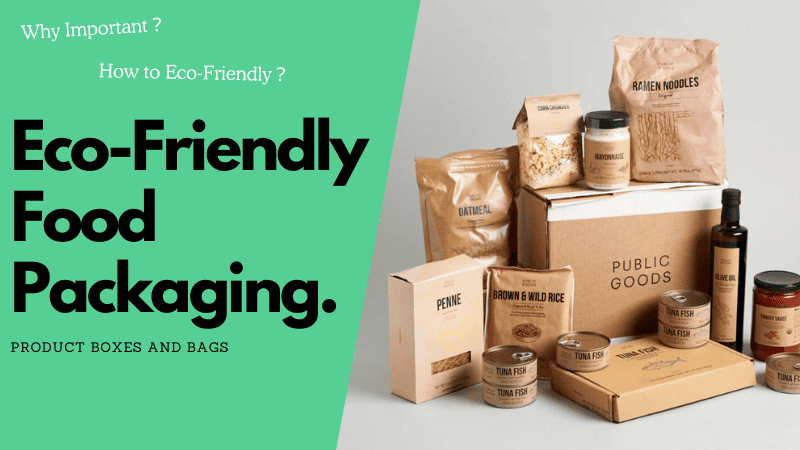
Plastic packaging raises some significant concerns. There’s the problem of plastic waste piling up in our oceans and landfills, the issue of tiny micro- and nanoplastics spreading everywhere, and the potential health risks from chemicals leaching into our food from packaging materials.
However, there’s some good news on the horizon. Eco-friendly packaging options are gaining traction, and they have some unique qualities. They often use bioplastics and materials like wheat, wood, and bamboo, which are biodegradable, reusable, and free from harmful chemicals.
While some studies have found traces of chemicals and NIAS in eco-friendly packaging, they generally result in much lower chemical transfer into our food and bodies compared to traditional plastics. So, they’re emerging as safer alternatives for both the environment and our health.
8 Types of Eco-Friendly Food Packaging to Consider
The world is becoming more environmentally conscious. A considerable 73% of consumers are open to changing their consumption habits to reduce their environmental impact, according to Nielsen. This presents a substantial opportunity for food manufacturers.
So, what eco-friendly packaging choices are currently available to the food and beverage industry? Here’s a list:
1. Recyclable Paper Bags

Recyclable paper bags are more than just handy carriers for groceries. They’re versatile and lightweight, which makes them suitable for a wide range of food products. From baked goods to fresh produce, paper bags are reliable and environmentally friendly.
What’s great is that they’re crafted from renewable resources like trees, and when they’ve served their purpose, they naturally decompose, reducing their environmental impact. And when your customers are done with them, they’re super easy to recycle, which makes them a convenient choice all around.
2. Paperboard Boxes

You’ve probably seen paperboard boxes housing cereals, snacks, and other dry goods. They’re not just sturdy; they’re also highly customizable, making them a fantastic choice for branding. What’s even better is that many of these boxes are crafted from sustainable sources, so you’re doing your bit for the planet. And since they’re recyclable, they help reduce waste, keeping your products fresh and the environment happy.
3. Cans
When it comes to preserving canned fruits, vegetables, and beverages, metal cans are the unsung heroes. They’re like little fortresses that protect your food from light, air, and moisture, ensuring your products stay fresh. Plus, they’re highly recyclable, and a significant chunk of them is usually made from recycled materials. So not only do they help cut down on resource consumption, but they also keep waste to a minimum.

4. Glass Jars and Containers
There’s something timeless about glass jars and containers. They’re the go-to choice for preserving the flavors and quality of sauces, jams, and pickles. And you know what’s cool? Glass is 100% recyclable, which means it can be recycled endlessly without losing its quality. Plus, it doesn’t release any harmful chemicals into your food, which makes it a solid choice for both your products and the environment.
5. Flexible Pouches
Flexible pouches are those handy, lightweight packets you see housing snacks, grains, and powders. They’re space-efficient, which is always a plus. Many of them are made from recyclable materials, which helps reduce their environmental impact. And here’s another perk: their lower shipping weight translates to a smaller carbon footprint. So they’re not just convenient; they’re earth-friendly too.
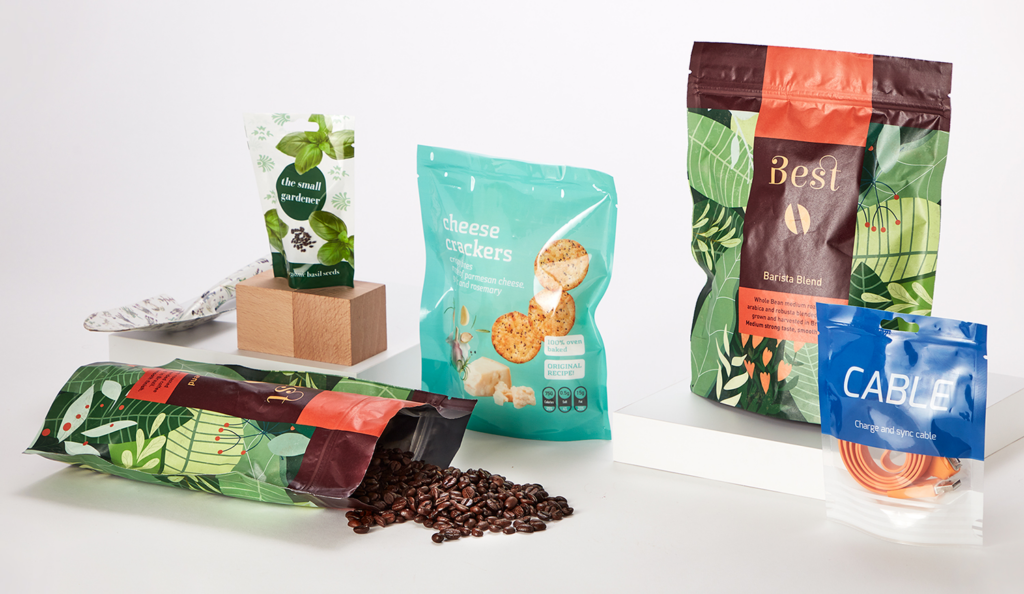
6. Biodegradable Plastic Alternatives
Biodegradable plastics like PLA and PHA are a breath of fresh air in the packaging world. They share some characteristics with conventional plastics, but with a twist – they break down more easily in the environment. This means they stick around for less time, which is a win for reducing plastic waste. While they’re not a silver bullet, they’re less harmful to ecosystems and wildlife, which is a step in the right direction.
7. Edible Films
Now, here’s something really intriguing – edible packaging. Imagine packaging that you can either dissolve in water or munch along with your food! It’s made from edible materials like seaweed or rice paper and is a creative way to reduce packaging waste. Plus, it adds a unique, eco-friendly dimension to your food products that can catch the eye of environmentally-conscious customers.
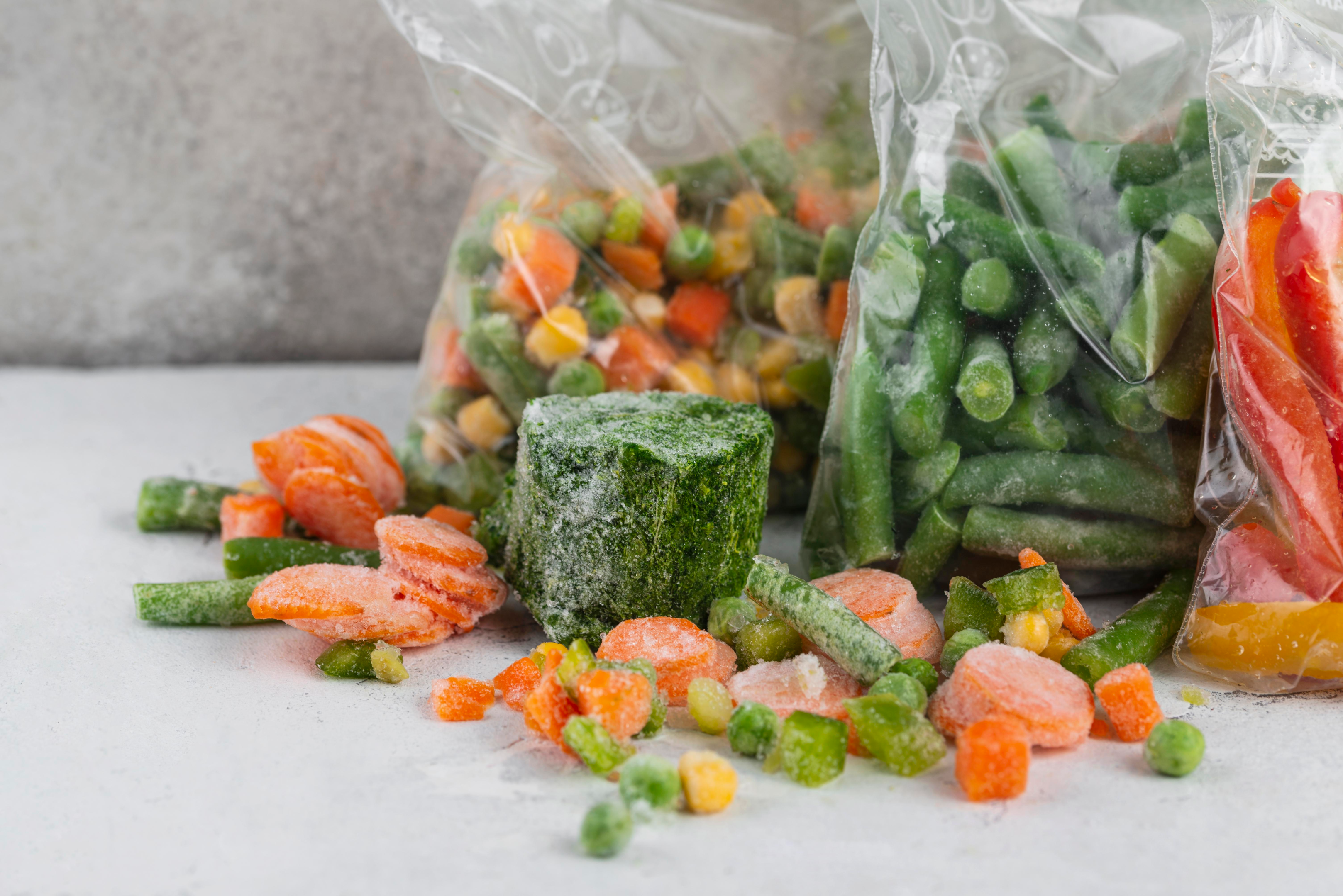
8. Reusable Takeaway Containers:
Promoting the use of reusable containers made from materials like stainless steel or bamboo is a sustainable move. Customers can bring these containers back for refilling, reducing single-use packaging waste. It’s not just eco-friendly; it also fosters customer loyalty and shows your commitment to environmental responsibility.
Factors to Consider When Selecting Sustainable Food Packaging
When you’re in the market for eco-friendly food packaging for your food business, it’s not a one-size-fits-all scenario. The options can be overwhelming, but don’t worry, we’ve got a few key factors to consider before making your choice.
While conventional plastics might seem like the easy and cost-effective route, it’s essential to understand their long-term environmental impact.
- First, let’s talk about the environment. Look closely at a material’s biodegradability or recyclability. Even better, consider reusable options. If something doesn’t score well in these areas, it might not be the best choice.
- Now, let’s discuss the cost. Sustainable options often come with a higher upfront price tag, but here’s the twist – they tend to last longer and need fewer replacements over time. So, in the grand scheme of things, they could actually save you money by reducing waste and cutting production costs.
- Lastly, think about practicality. Will this packaging keep your food items safe and sound? Is it user-friendly for your customers? Do you need any special equipment or training to handle or dispose of these materials responsibly?
By answering these questions, you’ll not only choose a packaging solution that’s kind to our planet but also one that fits seamlessly into your day-to-day operations.
5 Tips to Choose the Right Eco-Friendly Food Packaging
When it comes to selecting sustainable food packaging for your food business, there’s no one-size-fits-all solution. It’s a complex decision influenced by several crucial factors:
1. Responsible Sourcing
Consider the source of your packaging. What’s the manufacturer’s environmental track record? Are there better, more sustainable sources available? Proceed once you’re sure that the sourcing is responsible and sustainable and you’re opting for the best. With FSC-certified manufacturers, their packaging is sustainable packaging.
2. Material of the Packaging
The choice of packaging material isn’t a simple matter of one being better than another. For instance, cardboard is often seen as more environmentally friendly than plastic, largely due to plastic waste management issues.

However, it’s not a black-and-white situation. To truly understand sustainability, we must consider the entire life cycle of a product, including production and transportation. This is where Life Cycle Assessments (LCAs) come into play. LCAs provide data-driven insights into environmental costs, helping us assess the true impact of different packaging materials.
3. There Is No One-Size-Fits-All Solution
LCAs often yield surprising results, emphasizing that there’s no universal sustainable material. Each material has its pros and cons. Pick a company that invests significant effort in selecting the right material that aligns with your environmental goals.
4. Recycling Problems Solved
Effective recycling requires considering the packaging format and local recycling capabilities. Some packaging made of multiple materials can be challenging to recycle due to difficulties in separating these materials. Sorting issues with small plastic items, particularly those under 40mm wide, are common. Design guidelines play a vital role in simplifying recycling processes. Contact your waste management provider to understand what packaging is easily recyclable in your area, considering factors like material, size, decoration, and content.
5. Consider Choosing One Type of Packaging
To promote clarity for customers and streamline waste sorting, consider sticking to one type of packaging with a single end-of-life scenario, either compostable or recyclable packaging. This approach simplifies the disposal process and reinforces a clear message to consumers. However, ensure that this choice aligns with local waste management options.
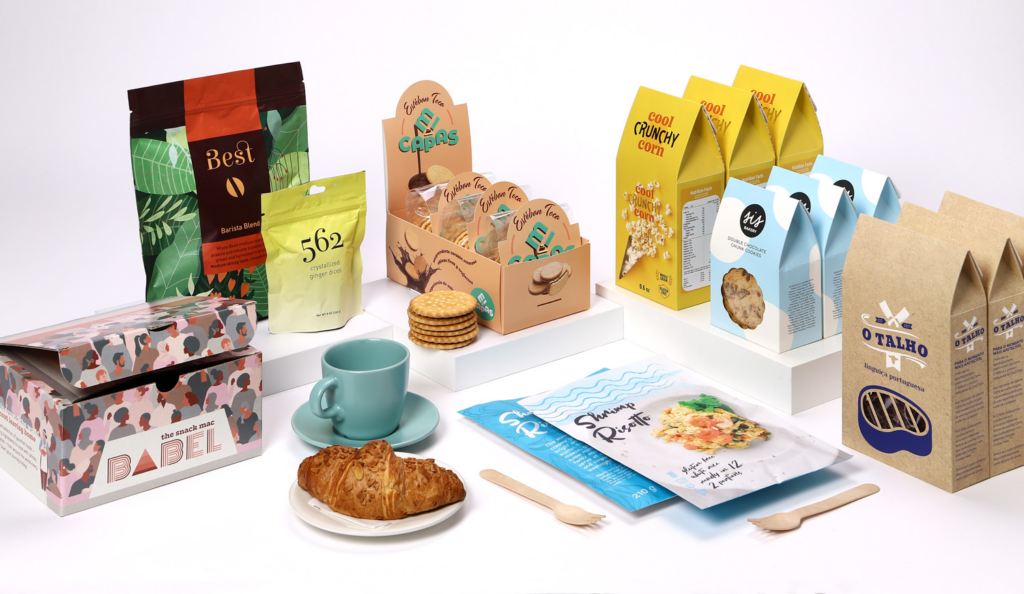
4 to Avoid “Not-Eco-Friendly Food Packaging”
Making the switch to eco-friendly food packaging in your food business is like embarking on a new adventure. Here are some practical tips to help you navigate this journey smoothly:
1. Say Goodbye to Single-Use Plastics
Let’s start with the basics. Single-use plastics, like plastic bags, cutlery, straws, or containers, are notorious for causing pollution. It’s a good idea to swap them out for eco-friendly packaging materials that can be reused or naturally break down.
2. Bid Farewell to Styrofoam
Styrofoam, or expanded polystyrene, is not eco-friendly at all. It doesn’t decompose easily and can be challenging to recycle. Instead, consider alternatives like molded pulp or corrugated cardboard, which are more planet-friendly.
3. Keep Away from Non-Recyclable Materials
Materials that can’t be recycled just add to our growing waste problem. To encourage sustainability, you might want to consider a small fee for disposable items like cups, spoons, forks, and extra packaging. This gentle nudge can prompt the use of reusable options and reduce waste.
4. Avoid Excessive Packaging
We all want our food products to arrive safely, but overdoing it with packaging isn’t the solution. It not only wastes materials but also raises shipping costs. Find that sweet spot between protecting your goods and avoiding excessive packaging. It’s a win-win for your food business and the environment.
Cost-Benefit Analysis of Eco-Friendly Food Packaging
When it comes to diving into eco-friendly food packaging and biodegradable options, it can feel like quite the task for any food business. It’s like finding the right balance between being kind to the environment and managing your costs – a bit of a tightrope act, if you will. When you decide to go the Eco-friendly food packaging, it’s important to assess its impact.
Let’s talk about the perks of going eco-friendly:
- Eco-friendly food packaging often means your food items last longer. That translates to fewer returns and less waste.
- People love sustainable stuff, so your food products get a credibility boost, and that’s always a win.
- Many eco-friendly packaging materials are capable of being recycled or compostable, which lines up nicely with waste reduction goals.
- More and more folks are on the lookout for green solutions. If you switch to eco-friendly, you enhance your food brand’s image and appeal to this eco-conscious crowd.
Now, onto the flip side, there might be a few challenges. Upfront costs could be a bit higher, and you might find certain eco-friendly items, like biodegradable plastic food containers, not as readily available. But here’s the thing – many food businesses have taken the eco-friendly plunge and found it more than worth it.
In the long run, the savings from less waste and the positive vibes your customers get from your green efforts tend to outweigh any initial investments. So, eco-friendly packaging isn’t just good for the planet; it’s good for your food business too.
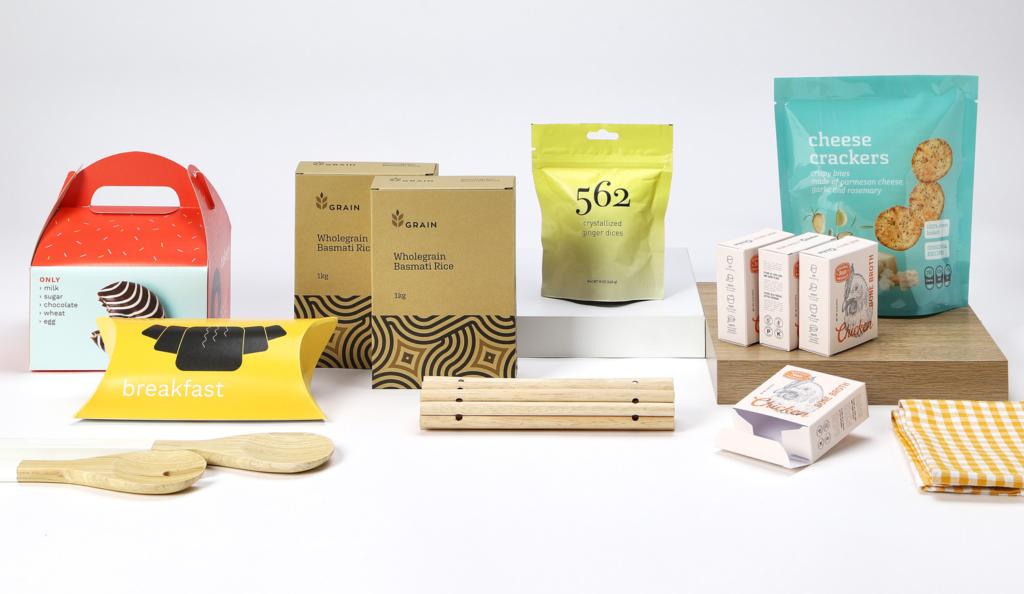
Conclusion
As we conclude our discussion on sustainable food packaging, it’s important to remember that opting for sustainable packaging materials isn’t solely about environmental conservation (though that’s a compelling reason).
It’s also a strategic choice for your food business. It leads to longer food product shelf life, enhances your food brand’s appeal to eco-conscious consumers, reduces waste, and ultimately makes good business sense.
For further insights and resources on sustainable practices, please explore our website. Together, we can drive positive change, one eco-friendly packaging decision at a time. Here’s to a greener and brighter future!
Discover the Perfect Solution for Your Business with Packoi
Meet Packoi, we believe every business should have access to quality branding. While you focus on growth, we provide tailored packaging solutions like mailer boxes, display boxes, and more. Our durable materials ensure your products stay safe and stylish during transit.
Elevate your brand with our luxurious gift and display boxes, and let us handle marketing materials like brochures and catalogs. We’re eco-conscious, licensed, and certified for quality. With Packoi, your satisfaction is our priority, no matter your order size or location. Contact us and experience top-notch packaging and marketing solutions—your success is our mission.




